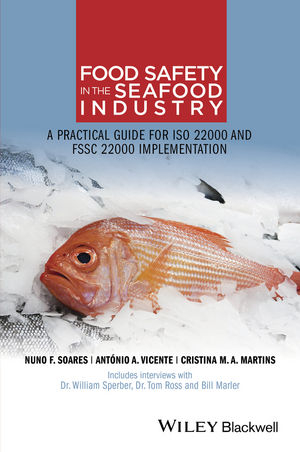
Food Safety in the Seafood Industry
Wiley-Blackwell (Verlag)
978-1-118-96507-8 (ISBN)
Concise and highly practical, this book comprises:
a presentation of seafood industry and its future perspectives
the description of the main hazards associated to seafood (including an annexe featuring the analysis of notifications related with such hazards published by Rapid Alert System for Food and Feed - RASFF)
interpretation of ISO 22000 clauses together with practical examples adapted to the seafood manufacturing industry
the presentation of the most recent food safety scheme FSSC 22000 and the interpretation of the additional clauses that this scheme introduces when compared to ISO 22000
This practical guide is a valuable resource for seafood industry quality managers, food technologists, managers, consultants, professors and students.
This book is a tool and a vehicle for further cooperation and information interchange around seafood safety and food safety systems. QR codes can be found throughout the book; when scanned they will allow the reader to contact the authors directly, know their personal views on each chapter and even access or request more details on the book content. We encourage the readers to use the QR codes or contact the editors via e-mail (foodsatefybooks@gmail.com) or Twitter (@foodsafetybooks) to make comments, suggestions or questions and to know how to access the Extended Book Content.
Nuno F. Soares is Quality Manager at Vanibru, Comercio de Produtos Alimentares Lda, Portugal. Antonio A. Vicente is Associate Professor with Habilitation at the Department of Biological Engineering, University of Minho. Cristina M. A. Martins is Key Account Manager, SGS Group, Portugal.
foreword, ix
Acknowledgements, xi
Disclaimer, xi
Introduction, xiii
Chapter 1 Fishery sector, 1
1.1 Characterization of seafood, 1
1.1.1 Classification, 1
1.1.2 Anatomy, 2
1.1.3 Chemical composition, 6
1.1.4 Marine ecosystem, 10
1.2 Characterization of the seafood industry, 11
1.2.1 Development of the fish industry, 11
1.2.2 F ish consumption and international trade, 12
1.2.3 Fish production, 13
1.2.4 F ish as a source of income, 13
1.2.5 World fleet, 13
1.2.6 The status of fishery resources, 14
1.2.7 Unveiling the future, 14
1.3 Hazard assessment in seafood, 15
1.3.1 Biological hazards, 16
1.3.2 Chemical hazards, 20
1.3.3 Physical hazards, 28
1.4 Risks and benefits of seafood consumption, 28
1.4.1 Seafood at the beginning of modern human brain, 28
1.4.2 Benefits and risks, 29
Chapter 2 Food safety, 31
2.1 Introduction, 31
2.2 The Codex Alimentarius, 34
2.3 HACCP system: Hazard analysis and critical control points, 35
2.3.1 History, 35
2.3.2 HACCP system, 37
2.4 F ood safety standards, 41
2.4.1 IFS Food Standard (Version 6), 42
2.4.2 BRC Global Standard for Food Safety (Issue 6), 43
2.4.3 SQF Code (7th Edition Level 2), 43
Chapter 3 The EN ISO 22000:2005, 45
3.1 History, 45
3.2 Structure, 46
3.3 Implementation, 47
3.3.1 Pressure (drivers), 47
3.3.2 Method of implementation, 50
3.3.3 Difficulties and challenges, 51
3.3.4 Benefits, 52
3.4 Changes in the organization, 52
3.4.1 Initial resistance, 52
3.4.2 Other changes, 53
3.4.3 F actors for success, 54
3.5 Technical specification ISO/TS 22002‐1, 55
Chapter 4 Food safety management system EN ISO 22000:2005, 57
4.1 Introduction (Clauses 1–3), 57
4.2 F ood safety management system (Clause 4), 59
4.2.1 General requirements (Clause 4.1), 59
4.2.2 Documentation requirements (Clause 4.2), 60
4.3 Management responsibility (Clause 5), 64
4.3.1 Management commitment (Clause 5.1), 65
4.3.2 F ood safety policy (Clause 5.2), 66
4.3.3 F ood Safety Management System planning (Clause 5.3), 66
4.3.4 Responsibility and authority (Clause 5.4), 67
4.3.5 F ood Safety Team leader (Clause 5.5), 67
4.3.6 Communication (Clause 5.6), 69
4.3.7 Emergency preparedness and response (Clause 5.7), 73
4.3.8 Management review (Clause 5.8), 75
4.4 Resource management (Clause 6), 75
4.4.1 Human resources (Clause 6.2), 76
4.4.2 Infrastructure and work environment (Clauses 6.3 and 6.4), 78
4.5 Planning and realization of safe products (Clause 7), 79
4.5.1 General (Clause 7.1), 79
4.5.2 Prerequisite program (PRPs) (Clause 7.2), 79
4.5.3 Preliminary steps to enable hazard analysis (Clause 7.3), 99
4.5.4 Hazard analysis (Clause 7.4), 104
4.5.5 Establishing the operational prerequisite programs (PRPs) (Clause 7.5), 112
4.5.6 Establishing the HACCP plan (Clause 7.6), 112
4.5.7 Updating of preliminary information and documents specifying the PRPs and the HACCP plan (Clause 7.7), 114
4.5.8 Verification planning (Clause 7.8), 115
4.5.9 Traceability system (Clause 7.9), 116
4.5.10 Control of nonconformity (Clause 7.10), 117
4.6 Validation, verification, and improvement of food safety management system (Clause 8), 122
4.6.1 General (Clause 8.1), 122
4.6.2 Validation of control measure combinations (Clause 8.2), 122
4.6.3 Control of monitoring and measuring (Clause 8.3), 123
4.6.4 F ood safety management system verification (Clause 8.4), 124
4.6.5 Improvement (Clause 8.5), 126
Chapter 5 The FSSC 22000 certification, 129
5.1 History, 129
5.2 Scope, 130
5.2.1 Certification scope, 131
5.3 Prerequisite program, 131
5.4 Additional requirements, 132
5.4.1 Specifications for services, 132
5.4.2 Supervision of personnel in application of food safety principles, 135
5.4.3 Specific regulatory requirements, 135
5.4.4 Announced but unscheduled audits of certified organizations, 136
5.4.5 Management of inputs, 136
Appendix 1, 139
Appendix 2, 145
References, 167
Index, 175
| Erscheinungsdatum | 17.03.2016 |
|---|---|
| Verlagsort | Hoboken |
| Sprache | englisch |
| Maße | 155 x 229 mm |
| Gewicht | 290 g |
| Themenwelt | Technik ► Lebensmitteltechnologie |
| Weitere Fachgebiete ► Handwerk | |
| Weitere Fachgebiete ► Land- / Forstwirtschaft / Fischerei | |
| ISBN-10 | 1-118-96507-8 / 1118965078 |
| ISBN-13 | 978-1-118-96507-8 / 9781118965078 |
| Zustand | Neuware |
| Haben Sie eine Frage zum Produkt? |
aus dem Bereich


